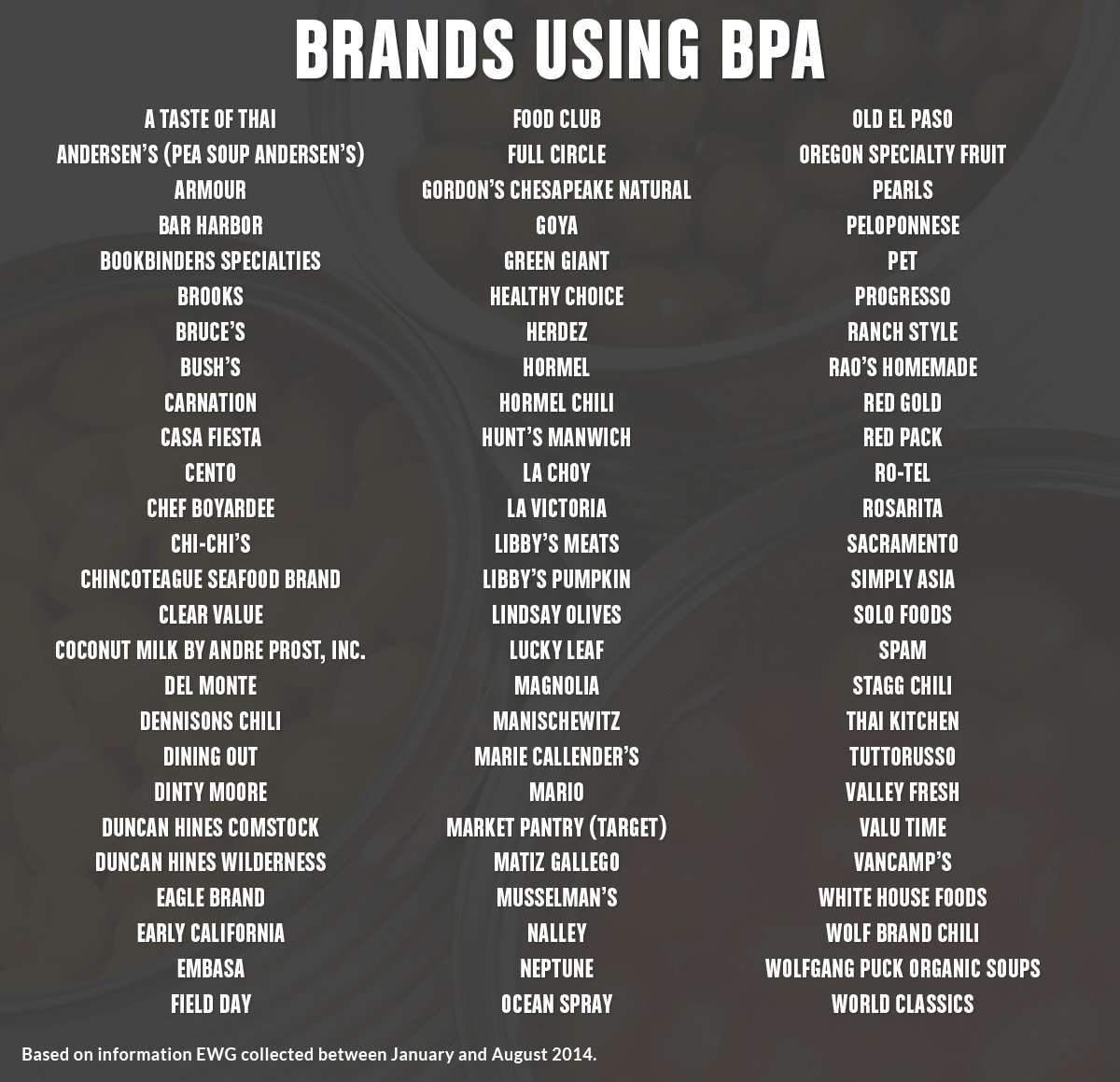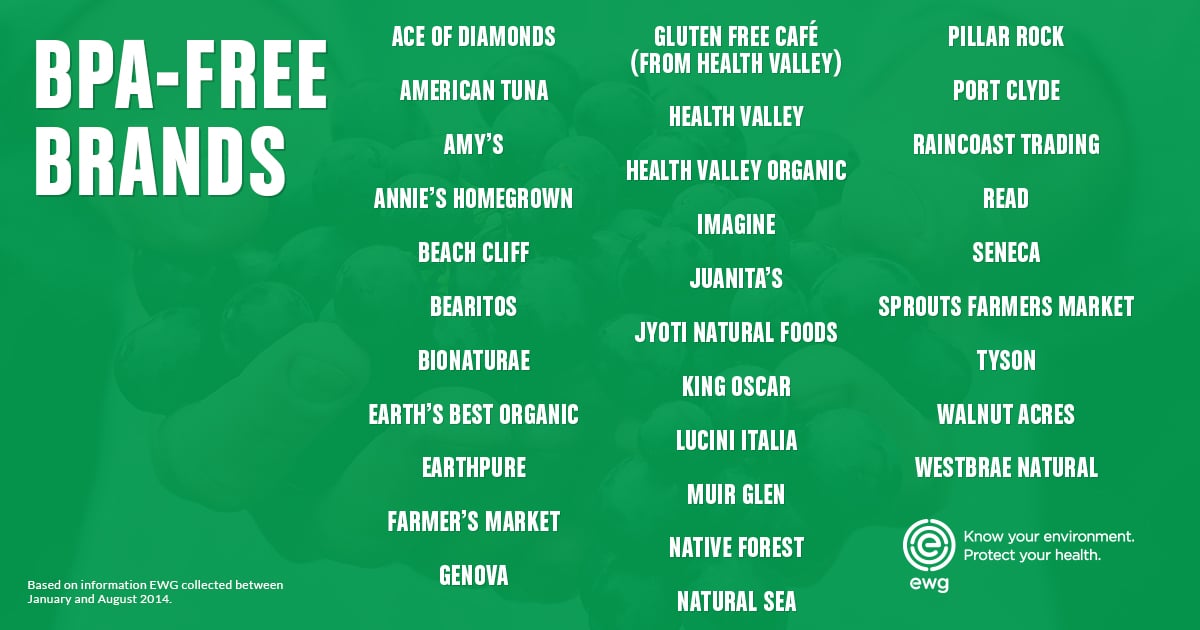New List of Which Canned Foods Contain BPA and Which Don't - How Do the Cans In Your Pantry Stack Up?
Our children are exposed to hundreds of chemicals on a daily basis; the average newborn has over 200 chemicals in their umbilical cord blood. Why is this scary?

Well, many of these chemicals have never been tested for safety on humans, let alone young children or fetuses. Once they are born, children will continue to be exposed to a cocktail of chemicals on a daily basis, since everything from mattresses, clothing, bath products, sofas, toys, plates, baby bottles, flooring, and food harbor some nasty chemicals. Are many of these chemicals dangerous to our children’s health? Most would say yes, since constant exposure (even in small amounts) over long periods of time to the most common chemicals like BPA, phthalates, flame retardants, pesticides, VOCs have been linked to a number of ailments (some won’t show up for years) including developmental disorders (autism, ADD etc), endocrine disruption, respiratory disorders and even cancer. Due to their small size, pound for pound, children get higher doses of chemicals than adults. So while genetics play a big role in your child’s intelligence and health, so can toxins.
The key to non-toxic parenting, however, is to avoid being overwhelmed. The goal is to achieve a life style change and not a quick fix. Thus, small, constant changes can have a big impact on your family’s health.
Here are 5 tips for non-toxic parenting that you can implement today
1. Ditch the plastic.
At some point in history, it seems, everything child related became synonymous with colorful plastic. Our children are surrounded by plastic everything: toys, baby bottles, sippy cups, plates, play jewelry. Why are some plastics bad? Some plastics can expose your child to chemicals like BPA and phthalates which are proven endocrine disruptors. Even BPA free products are proving to be just as bad to your child’s health as those with BPA.
The reality is that, even if you wanted to, you would not be able to eliminate 100% of plastics in your children’s lives. BUT if you stop buying plastics at home, you can relax a bit about what happens outside of the home.
Alternatives? Choose wooden toys, stainless steel or glass (with silicon protectors for the little ones) bottles, cups, plates and utensils.
2. Dust. Like a judgy mom is coming over this afternoon.
I know moms and dads have our plates full and keeping a tidy home is not always entirely possible, however your house’s dust is most likely pretty toxic. Toxic chemicals like flame retardants (which can be found on most upholstered furniture and electronics) migrate easily from the product they are sprayed on to your house’s dust. The toxic dust then makes its home in the most child friendly spots in your home: on the floor and amongst toys that are rarely cleaned. When we don’t dust, our young children lay, crawl or play with the dusty items - thus exposing themselves to the chemicals. Keep dust to a minimum around the house, vacuum often (ideally with a vacuum that has a HEPA filter) and throw toys in the bathtub for a quick scrub down.
3. Choose the right jammies.
Most parents don’t like the idea of tucking their children in at night with jammies full of flame retardants- unfortunately, many are. Why? The US’s Federal Consumer Products Safety Commission (CPSC) children’s sleepwear flammability standards require manufacturers of “Children’s Sleepwear such as nightgowns, pajamas, or similar or related items, such as robes” to use flame retardants.
The flame retardants currently in use, such as tetrakis phosphnium chloride, have been linked to health effects including tumor promoting activities, liver, nervous and reproductive system damage.
The good news is that not all PJ’s are created equally. The pajamas that usually do contain the flame retardants are warm ones made out of fleece and other warm material. Instead, choose tight fitting garments that do not have flame retardants. These do, however, have to be labeled with a hangtag that clearly states that the item should be worn tight fitting and does not have flame retardants. Also exempt from the standard are PJ’s smaller than 9 months and larger than size 6x.
4. Wash Wash Wash their hands... with soap not gel
In an effort to avoid having your children continuously come home from the playground with a new virus (which, will always then contaminate the entire family) many well intended parents rely heavily on antibacterial gels to ‘wash’ their children’s hands- at the park, after class, throughout the day, every day. In fact, at many preschools, teachers ‘wash’ the student's hands with hand sanitizer gel before lunch.
Many of these antibacterial products (including body wash, hand soap, wipes and gels) contain chemicals like triclosan and triclocarban which, with constant daily use, could be increasing bacterial resistance to antibiotics and disrupting thyroid function in the user. Additionally, no evidence has been found that they are more effective in preventing the spread of germs than washing your hands with soap and water.
Your alternatives? Hand washing is really important- not only to avoid the spread of germs but, also to decrease the chemicals transferred from your children’s hands to their mouths. Plain old soap and water work best (read the label and avoid fragrance in addition to triclosan and triclocarban when buying soap) but for those situations when these are not available, choose gels that are alcohol based. Avoid products that claim to be “antibacterial” or “antimicrobial”.
5. Make sure the color in your child’s diet is natural not synthetic
When a nutritionist recommends you eat a colorful diet he/she is referring to colorful fruits and veggies. Unfortunately, many kids today eat a different kind of colorful diet : one produced by a variety of artificial colors. The problem with artificial colors? They have been found to increase hyperactivity in most children and the most common dyes ( Red 40, Yellow 5, and Yellow 6) have been found to be contaminated with known carcinogens; Red 3 in itself is a known carcinogen.
Considering over 5.8 million children in the US have been diagnosed with ADHD and 69% of those are taking medication, artificial dyes in our children’s diets are indeed a big deal. Study’s have found that hyperactive children’s behavior improves dramatically when these artificial colorings are removed from their diet- no medication necessary.
Does your child regularly eat peanut butter crackers, cereals, soups, chips, granola bars, candy, soft drinks, fruit roll ups, frozen meals or cupcakes? Well known brands like Kool Aid, Sunny D, Kraft, Cap’n Crunch, Betty Crocker, Cheerios, Aunt Jemima, Keebler among many others, all contain high levels of food coloring
As parents, the tricky part is that it is not always obvious which foods contain food dye, nor how much they contain. For example, a bowl of prepackaged macaroni and cheese or a bowl of children’s cereals could have 30 mg of dye which is the amount found to cause behavioral problems in some children.
The EU requires food manufacturers to label foods containing dyes stating “may have an adverse effect on activity and attention to children”- this regulation has resulted in many manufacturers switching from artificial food dyes to natural food coloring in the EU. Most, however, kept the artificial colors in the food they sell in the US. Kraft is one company that recently agreed to remove all artificial food dyes from their mac & cheese sold in the US by 2016 (this had been available in Europe for years).
How to remove these chemicals from your children’s diet? Look for natural, unprocessed food (ideally organic) or turn to the food label and search for natural food coloring like Beet juice, beta-carotene, blueberry juice concentrate, carrot juice, grape skin extract, paprika, purple sweet potato or corn, red cabbage, and turmeric are some

Wondering which canned foods are BPA free? EWG posted their list of 31 brands (12%) they found to be using BPA free cans for all of their canned products. Unfortunately, we still wouldn’t necessarily recommend buying these because these companies were vague and most did not provide what the substitute chemical used is - so no one really knows if alternatives being substituted for BPA-based epoxy are safe.

What to do?
Since there is no federal law requiring food manufacturers to label their products that contain BPA linings, it is up to you as the consumer to protect your family.
Choose glass containers and carton/tetrapack containers whenever possible. Everything from tomato sauce, to soups, to beans can be found in glass or tetrapack containers in most supermarkets and this will always be your safest option.
When you have no other choice than to buy canned food, choose from EWG’s list of ‘BPA free’ canned foods, but try to keep these foods at a minimum.
Another option might be choosing frozen vegetables in lieu of canned vegetables.
Finally, always opt for fresh fruits and vegetables when these are an option! Especially for children and pregnant women.
